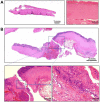Chronic Appendicitis Caused by a Perforating Fish Bone: Case Report and Brief Literature Review
- PMID: 35738623
- PMCID: PMC9301403
- DOI: 10.21873/invivo.12922
Chronic Appendicitis Caused by a Perforating Fish Bone: Case Report and Brief Literature Review
Abstract
Background: Appendicitis caused by a foreign body is extremely rare. We report a case of chronic appendicitis caused by a perforating fish bone.
Case report: The patient was a 50-year-old Japanese man. He felt dull lower abdominal pain for 2 months and diagnosed as appendicitis caused by a perforating fish bone. He underwent emergency laparoscopic surgery. The fish bone had perforated through the appendix wall. The fish bone was initially removed followed by laparoscopic appendectomy. Pathological investigation revealed a transmural cut line of approximately 0.5 mm that was surrounded by fibrous tissue with inflammation.
Conclusion: This is the first reported case of fish bone-induced chronic appendicitis that underwent laparoscopic appendectomy. For optimum outcome, a correct diagnosis based on a detailed consultation and imaging tests, and an operation performed after careful planning are needed.
Keywords: Fish bone; chronic appendicitis; perforation.
Copyright © 2022, International Institute of Anticancer Research (Dr. George J. Delinasios), All rights reserved.
Conflict of interest statement
The Authors have no conflicts of interest or financial ties to disclose in relation to this study.
Figures



References
Publication types
MeSH terms
LinkOut - more resources
Full Text Sources
Medical
